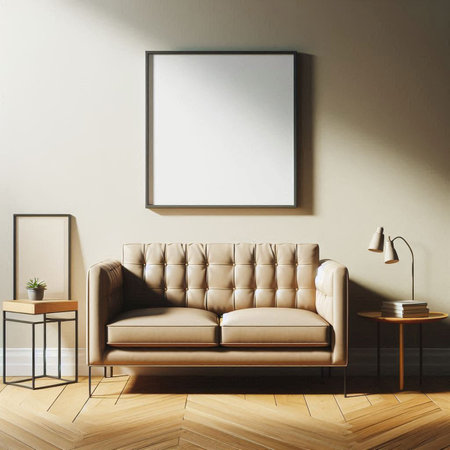1. Understanding Feng Shui and Its Role in Modern American Homes
Feng Shui is an ancient Chinese practice that focuses on creating harmony between people and their environments. In recent years, more Americans are discovering how these principles can help transform their living spaces, especially the living room, into places that feel balanced, inviting, and full of positive energy.
What Is Feng Shui?
At its core, Feng Shui is about arranging your home to encourage good energy flow—often called “chi” or “qi.” This involves considering how furniture, colors, lighting, and even decorative items work together to support well-being and happiness for everyone living there.
Why Focus on the Living Room?
The living room is often the heart of an American home. It’s where families gather, friends visit, and relaxation happens after a long day. Because of this, the energy in this space greatly affects your daily mood and relationships. Applying Feng Shui in your living room can help create a welcoming environment that supports both comfort and connection.
How Feng Shui Fits with U.S. Interiors
Contemporary American interiors typically feature open layouts, neutral color schemes, and a mix of modern and traditional elements. Feng Shui adapts well to these styles by offering flexible guidelines that don’t require you to change everything—just small tweaks to enhance the natural flow and atmosphere of your space.
Key Benefits of Using Feng Shui in U.S. Living Rooms
| Benefit | Description |
|---|---|
| Increased Harmony | Promotes peaceful interactions among family members and guests |
| Better Energy Flow | Makes the room feel brighter and more comfortable |
| Personalized Style | Easily matches your existing decor with thoughtful color choices |
| Welcoming Atmosphere | Makes visitors feel at home as soon as they walk in |
By understanding the basics of Feng Shui and how it fits into American homes, you can start making changes that truly improve the look and feel of your living room—one step at a time.
2. Top Feng Shui Color Choices for Living Rooms
When choosing the best Feng Shui colors for your living room, it’s helpful to balance ancient wisdom with popular American style. The right colors not only create a welcoming atmosphere but also promote positive energy flow, or “chi,” in your home. Below, we’ll explore recommended shades and their meanings, along with tips for matching them to U.S. interior trends.
Key Feng Shui Living Room Colors and Their Benefits
| Color | Feng Shui Meaning | Popular Uses in U.S. Interiors |
|---|---|---|
| Soft Green | Growth, renewal, harmony | Wall paint, plants, throw pillows |
| Warm Beige or Taupe | Stability, grounding, relaxation | Sofas, rugs, curtains |
| Pale Blue | Calmness, peace, clarity | Accent chairs, artwork, vases |
| Creamy White | Purity, openness, fresh beginnings | Main wall color, trim, lampshades |
| Earthy Brown | Support, comfort, security | Wood furniture, baskets, shelving |
| Gentle Yellow or Gold Accents | Cheerfulness, warmth, optimism | Cushions, picture frames, light fixtures |
| Muted Gray | Balance, sophistication, calm energy | Sofas, area rugs, accent walls |
| Burgundy or Deep Red (in moderation) | Passion, vitality, abundance (should be used sparingly) | Pillows, small décor pieces, art highlights |
Blending Feng Shui with American Design Trends
Many American living rooms feature open floor plans and lots of natural light. Light neutrals like creamy white and soft beige are ideal for making spaces feel larger and brighter while supporting good energy flow. Pair these base tones with nature-inspired greens or blues for a calming vibe that fits both Feng Shui principles and current U.S. design preferences.
Tips for Using Feng Shui Colors in Your Living Room:
- Create Balance: Mix warm and cool tones for harmony.
- Add Texture: Use pillows or throws in different fabrics and shades to layer color without overwhelming the space.
- Nod to Nature: Incorporate live plants or wood elements to boost life energy (“sheng chi”).
- Avoid Overuse of Bright Reds: In Feng Shui, too much red can be overstimulating. Use it only as an accent.
Sample Color Combinations for U.S. Living Rooms:
- Creamy white walls + sage green sofa + gold accents for a fresh yet cozy look.
- Taupe walls + navy blue armchairs + earth-toned décor for a grounded and inviting feel.
Selecting colors with both Feng Shui benefits and local trends in mind will help you create a living room that feels comfortable and full of positive energy.
![]()
3. How Color Impacts Mood and Relationships at Home
When choosing Feng Shui colors for your living room, its helpful to understand how different shades can influence the mood and energy of your home. In the United States, living rooms are often the heart of family life—a place to relax, connect, and entertain guests. The right color choices can help create a welcoming and harmonious atmosphere for everyone who walks through the door.
The Psychological and Energetic Effects of Popular Colors
| Color | Psychological Effect | Feng Shui Energy | Best For |
|---|---|---|---|
| Blue | Calming, peaceful, reduces stress | Water element: promotes relaxation and communication | Family conversations, unwinding after work |
| Green | Refreshing, balanced, brings nature indoors | Wood element: supports growth and healing | Creating a sense of renewal and harmony |
| Yellow | Cheerful, uplifting, energizing | Earth element: encourages warmth and stability | Lively gatherings, boosting optimism in the space |
| Gray | Sophisticated, neutral, calming base color | Metal element: supports clarity and precision | A modern look that doesn’t overpower other colors |
| Cream/Beige | Welcoming, cozy, softens strong accents | Earth element: enhances comfort and togetherness | Makes guests feel at home; easy to decorate around |
| Red (as an accent) | Energizing, passionate, stimulating conversation | Fire element: boosts excitement and connection when used sparingly | Pillows or art to spark interest without overwhelming the room |
| Purple (muted tones) | Luxe, creative, inspires imagination | Fire/Wood elements: encourages creativity and inspiration | Adds depth and personality for artistic families or social spaces |
| Browns/Wood Tones | Grounding, secure, brings nature’s warmth inside | Wood/Earth elements: enhances stability and comfort | Coffee tables, shelving—perfect for traditional or rustic U.S. homes |
The Role of Color in Family Connection and Comfort
The colors you choose for your living room can do more than just look good—they help shape daily experiences. Warm earth tones like beige or soft yellow make people feel comfortable and welcomed. Calming blues or greens can encourage open conversations after a busy day. Adding pops of red or orange can spark energy during family game nights or gatherings with friends. Think about what kind of mood you want to set in your living space and use these Feng Shui color guidelines as inspiration.
Tips for Combining Colors in U.S. Living Rooms
- Create balance: Mix neutral bases with one or two accent colors for harmony.
- Add personal touches: Use pillows, rugs, or artwork to introduce colors you love without repainting walls.
- Let natural light guide you: Brighter rooms can handle deeper colors; dimmer spaces benefit from lighter shades.
A Welcoming Space Starts with the Right Palette
- Create balance: Mix neutral bases with one or two accent colors for harmony.
- Add personal touches: Use pillows, rugs, or artwork to introduce colors you love without repainting walls.
- Let natural light guide you: Brighter rooms can handle deeper colors; dimmer spaces benefit from lighter shades.
A Welcoming Space Starts with the Right Palette
No matter your style—from modern farmhouse to cozy cottage—the right Feng Shui-inspired colors will help your living room feel both inviting and uniquely American. Use color to support connection, comfort, and positive energy for everyone in your home.
4. Practical Tips for Incorporating Feng Shui Colors
Mixing and Matching Paint, Furniture, and Decor
Bringing Feng Shui colors into your living room doesn’t mean you need a complete makeover. Instead, focus on blending harmonious shades with your existing style. Here are simple ways to get started:
Choose a Balanced Color Palette
Start by selecting two or three main Feng Shui colors that fit your home’s energy and your personal taste. Here’s how they commonly appear in American interiors:
| Feng Shui Color | Energy Element | Example Use in U.S. Homes |
|---|---|---|
| Blue | Water (Calm, Relaxation) | Pale blue walls, navy throw pillows, coastal artwork |
| Green | Wood (Growth, Renewal) | Sage green sofa, leafy plants, nature-inspired rugs |
| Earth Tones (Beige, Tan) | Earth (Stability, Comfort) | Light tan wall paint, wooden coffee table, cream curtains |
| Red Accents | Fire (Passion, Energy) | Burgundy armchair, red vases, patterned cushions |
| White & Gray | Metal (Clarity, Precision) | White trim, metallic frames, gray area rugs |
Apply Colors Strategically in Your Living Room
You don’t have to use every color equally—think about what mood you want to create:
- Main Walls: Soft earth tones like beige or light gray make great base colors for most American homes.
- Larger Furniture: Choose sofas or sectionals in calming greens or blues for a soothing vibe.
- Pillows and Throws: Add pops of red or gold to energize the space without overwhelming it.
- Drapes and Rugs: Layer textures using neutral shades with subtle color accents.
- Artwork and Decor: Pick pieces that echo your chosen palette—like ocean prints for blue or botanical art for green.
Real-Life Example: Suburban Family Living Room
A family in Austin wanted their open-concept living room to feel welcoming and balanced. They painted the walls a warm tan (Earth), chose a deep blue sectional (Water), added green potted plants (Wood), and used golden yellow throw pillows (Fire). Metallic picture frames finished off the look (Metal). This mix created harmony and reflected their personal style.
Troubleshooting Common Challenges
- If you love bold colors: Use vibrant shades as accents through art or accessories rather than large surfaces.
- If your space feels too neutral: Bring in lively throws or decorative objects to introduce warmth and energy.
- If you rent and can’t paint walls: Focus on furniture covers, rugs, curtains, and removable wall decals in your chosen Feng Shui hues.
The key is to layer these elements thoughtfully so the space feels inviting and balanced for everyone who enters.
5. Common Mistakes and How to Avoid Them
Overusing Bold or Dark Colors
One of the most frequent Feng Shui color mistakes in U.S. living rooms is relying too heavily on bold or dark shades, such as deep reds, navy blues, or charcoal grays. While these colors can add drama, overuse may create a heavy or chaotic atmosphere that disrupts energy flow.
How to Fix It
- Use bold colors as accents—think throw pillows, art, or a single wall—instead of painting the entire room.
- Balance with plenty of neutrals like soft whites, beiges, or light grays.
Mismatching Color Elements with Room Direction
Feng Shui emphasizes aligning colors with the cardinal direction your living room faces. Many U.S. homes overlook this detail, leading to mismatched energies that can affect comfort and harmony.
| Room Direction | Best Feng Shui Colors | Avoid These Colors |
|---|---|---|
| North | Blues, black, gray | Earthy yellows, browns |
| South | Reds, orange, purple | Blues, black |
| East/SE | Greens, browns (wood tones) | Metallics (white, gray) |
| West/NW | White, gray, metallics | Reds, fiery shades |
How to Fix It
- Check which direction your living room faces using a compass app.
- Select colors that correspond to that direction’s ideal palette for balanced energy.
Ineffective Use of Accent Colors
A common misconception is that any pop of color will energize a space. Randomly chosen accent hues can clash with existing décor and disrupt the intended energy flow.
How to Fix It
- Select accent colors that complement the main Feng Shui palette of your room.
- If your base is neutral, choose accents based on the element you want to enhance (e.g., green for growth/health, blue for calmness).
- Avoid using more than three different accent colors in one space.
Ignoring Personal Style and Comfort
Sometimes homeowners apply strict Feng Shui color rules without considering their own taste. This often leads to spaces that feel forced or uncomfortable rather than welcoming.
How to Fix It
- Meld Feng Shui guidelines with your personal style by choosing shades within recommended color families that you naturally enjoy.
- Add personal touches through artwork or textiles while keeping the overall color scheme harmonious.


